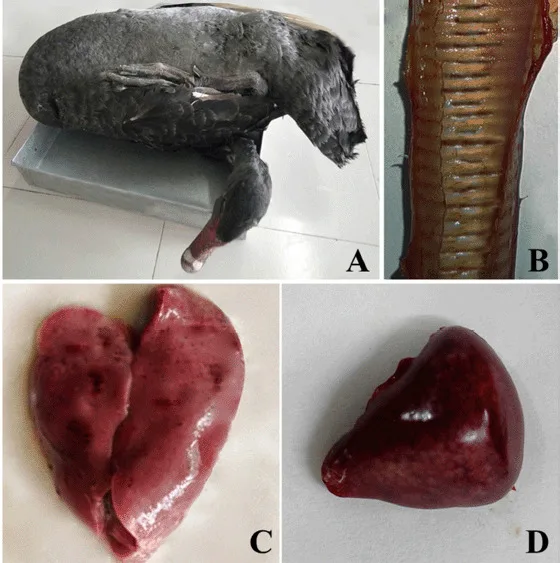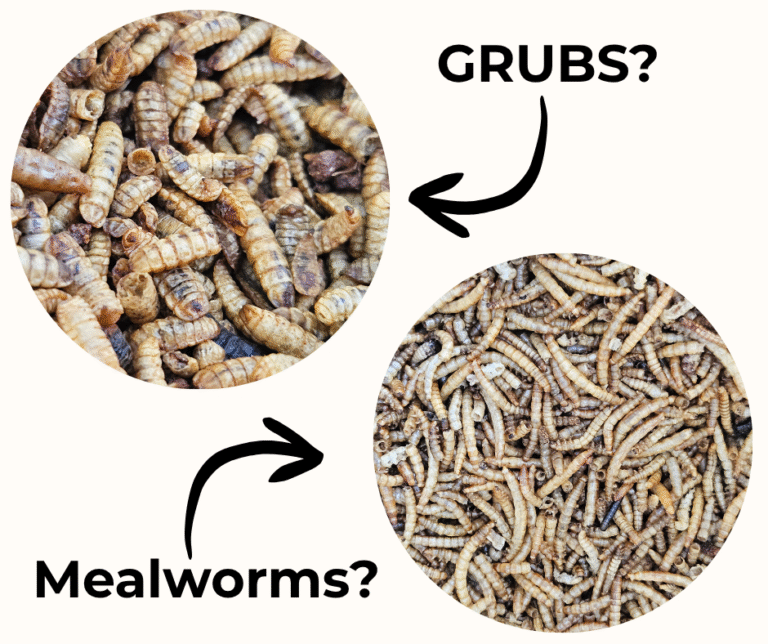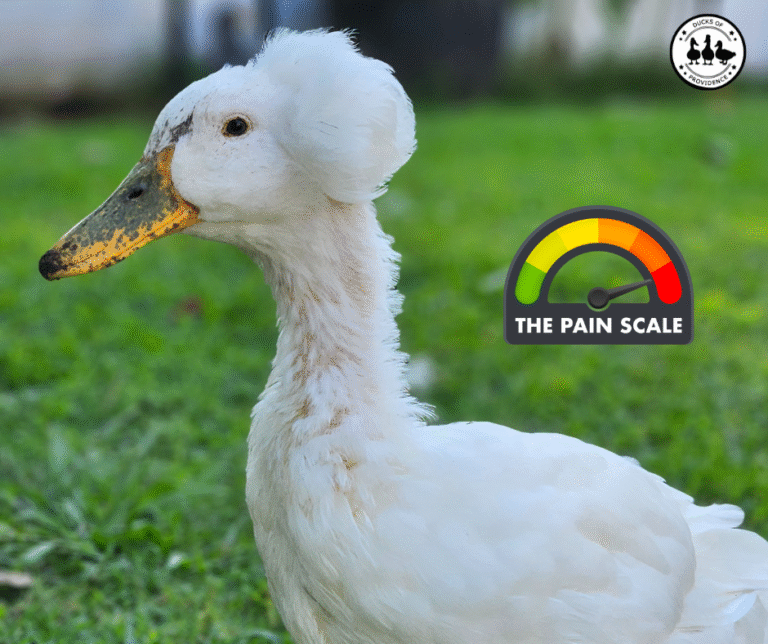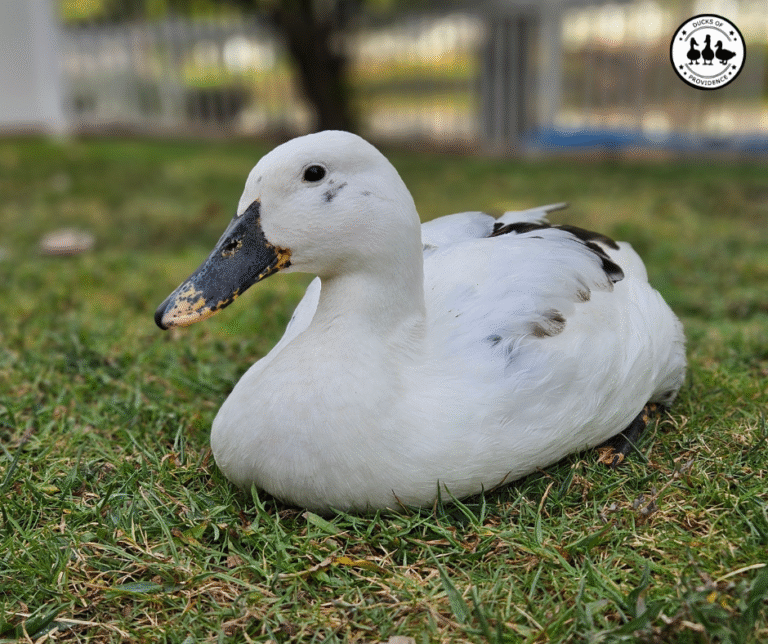
Duck Virus Enteritis: How to Protect Your Flock from This Deadly Duck Disease
Duck Virus Enteritis (DVE), also known as duck plague, is a highly contagious disease caused by a herpesvirus that primarily affects ducks, geese, and swans. It can have devastating effects on both domestic and wild waterfowl populations. This article gives a detailed overview.
🩺 This article is part of our Duck Health Conditions Series.
Ducks of Providence is free, thanks to reader support! Ads and affiliate links help us cover costs—if you shop through our links, we may earn a small commission at no extra cost to you. Thanks for helping keep our content free and our ducks happy! 🦆 Learn more
What Causes Duck Virus Enteritis?
Duck Virus Enteritis (DVE) is caused by a herpesvirus called Anatid alphaherpesvirus 1. This virus specifically targets ducks, geese, and swans. It is highly contagious and can spread rapidly in both domestic and wild waterfowl populations. The virus can survive in the environment, particularly in water, and is spread through direct contact with infected birds or contaminated water, feces, or surfaces.
Here’s a closer look at how the disease spreads and why it’s so dangerous:
Transmission of DVE
- Direct Contact:
Infected birds shed the virus through their bodily fluids, including saliva, nasal discharge, and feces. Healthy ducks can become infected through direct contact with these fluids. - Contaminated Water Sources:
- Water is a major vector for DVE transmission. The virus can survive for extended periods in water, especially in ponds, lakes, or other communal water sources. Ducks drinking or swimming in contaminated water can quickly contract the virus.
- Environmental Contamination:
- The virus can persist in moist environments, including soil and bedding, making it possible for healthy ducks to pick it up from contaminated surfaces or materials.
- Shoes, tools, and equipment used by caretakers can also act as vectors if proper disinfection is not practiced.
- Wild Birds as Carriers:
Wild waterfowl, especially migratory ducks and geese, can carry and spread the virus without always showing symptoms. This poses a significant risk to domestic flocks, especially those kept near ponds or open water. - Vertical Transmission:
Although rare, the virus may be transmitted through infected eggs. This can result in infected ducklings hatching with the virus already in their system.

Why Is DVE So Dangerous?
- Highly Infectious:
The virus spreads quickly, especially in environments where ducks congregate, such as breeding facilities, wetlands, and backyard flocks. - Latency and Reactivation:
Like many herpesviruses, DVE can become latent in infected birds. This means a bird may appear healthy but still harbor the virus. During times of stress (e.g., molting, overcrowding, or extreme weather), the virus can reactivate, causing outbreaks. - Environmental Resilience:
The DVE virus is hardy and can survive in water or moist conditions for weeks, even without a host. This makes controlling its spread challenging, especially in areas where wild birds frequent. - Host-Specific:
While DVE primarily affects ducks, geese, and swans, it does not infect other poultry, such as chickens or turkeys. However, these species can still act as mechanical carriers if they come into contact with the virus.

Understanding how DVE is transmitted underscores the importance of strict biosecurity measures, regular cleaning, and close monitoring of your ducks’ health. Reducing exposure to wild birds and contaminated water is key to keeping your flock safe.
Symptoms of Duck Virus Enteritis
The signs of DVE can vary but commonly include:
- Sudden Death: Often, no symptoms are noticed before ducks die.
- Depression and Lethargy: Infected birds may appear weak and inactive.
- Bloody Discharge: Blood-streaked droppings or blood around the vent.
- Diarrhea: Watery or bloody stool.
- Drooped Wings and Neck: A classic symptom indicating severe illness.
- Eye and Nasal Discharge: Watery or mucous-like discharges from the eyes and nose.
- Protruding Tongue: Caused by swelling in the head or throat area.
Duck Virus Enteritis (DVE) manifests in various ways, depending on the severity of the infection, the age and health of the duck, and environmental conditions. The symptoms can range from subtle signs of illness to sudden death with no prior warning.
Here’s a detailed breakdown of the symptoms:
Early Signs of Infection DVE
- Lethargy:
Infected ducks often become unusually quiet and inactive. They may sit in one place for long periods, even during feeding times. - Loss of Appetite:
Affected ducks may stop eating or drink less water, leading to noticeable weight loss over a short period. - Reluctance to Move:
Ducks may appear reluctant to move, preferring to stay isolated from the rest of the flock. - Feather Ruffling:
Feathers may appear disheveled or unkempt as the duck’s overall health declines.
Progressive Symptoms of DVE
- Watery or Bloody Diarrhea:
- Diarrhea is a hallmark symptom of DVE, often with a watery consistency.
- In more severe cases, the diarrhea may contain blood or mucus.
- Nasal and Eye Discharge:
Ducks may have watery or mucous-like discharge from their nostrils and eyes, sometimes accompanied by swelling around these areas. - Depressed Posture:
Infected ducks often appear hunched over, with their wings drooped and heads lowered. - Swollen Head and Neck:
Swelling in the face, neck, or throat can occur, sometimes severe enough to cause difficulty breathing or swallowing.
Severe and Advanced Symptoms of DVE
- Bleeding from the Cloaca (Vent):
One of the most alarming signs is blood around the cloaca, a result of internal hemorrhaging caused by the virus. - Protruding Tongue:
Swelling in the head and throat may cause the tongue to protrude, which can be distressing to see. - Seizures and Tremors:
Neurological symptoms like seizures or trembling may occur in some ducks as the disease progresses. - Sudden Death:
Ducks may die suddenly without showing obvious symptoms in many cases, especially during an outbreak.

Subtle Signs in Carrier Ducks
Some ducks may survive the infection and become carriers of the virus. These ducks may not exhibit the dramatic symptoms of active disease but might show subtle signs, such as:
- Slight feather discoloration or dullness.
- Periodic lethargy or reduced egg production.
Signs in the Flock as a Whole
When DVE strikes, the impact on the flock can be devastating. You might observe:
- High Mortality Rates: Large numbers of ducks die within a short period.
- Widespread Lethargy: Multiple ducks displaying signs of weakness and inactivity.
- Bloodstains in the Environment: Blood on bedding, around water sources, or in feces.
Differentiating DVE from Other Illnesses
The symptoms of DVE can sometimes resemble other duck illnesses, such as:
- Botulism: Causes paralysis but lacks the bloody diarrhea characteristic of DVE.
- Avian Influenza: Also causes sudden death and lethargy but often involves respiratory distress.
- Duck Cholera: Shares symptoms like diarrhea and sudden death but is bacterial, not viral.
Definitive diagnosis often requires laboratory testing to confirm DVE.
If you notice these symptoms in your ducks, especially during an outbreak, isolate the affected birds immediately and contact a veterinarian or local wildlife authority. Quick action can help reduce the spread and potentially save other members of your flock. Have you noticed any of these symptoms in your ducks before? Let me know if you’d like advice on recognizing early signs or improving your flock’s health!
How Is Duck Virus Enteritis (DVE) Diagnosed?
Diagnosing Duck Virus Enteritis (DVE) requires a combination of clinical observation, necropsy findings, and laboratory testing. Since the symptoms of DVE can overlap with other duck diseases, a definitive diagnosis often hinges on specialized diagnostic methods. Here’s a detailed look at how veterinarians and wildlife specialists diagnose DVE:
Clinical Signs in the Flock
A veterinarian may first suspect DVE based on the flock’s behavior and physical symptoms, such as:
- Sudden, high mortality rates, especially in ducks living near natural water sources.
- Bloody diarrhea, swollen heads, and lethargy.
- Cloacal bleeding and other signs of internal hemorrhaging.
While these signs can strongly suggest DVE, they are not conclusive without further investigation.
Necropsy (Post-Mortem Examination)
A necropsy is one of the most effective ways to diagnose DVE. Ducks that have died or been euthanized during an outbreak are examined for internal lesions and other characteristic changes caused by the virus. Key findings may include:
External Findings
- Bleeding from the cloaca and mucosal surfaces.
- Feathers matted with blood or feces.
Internal Findings
- Hemorrhages in Organs:
Internal bleeding is common, particularly in the intestines, liver, and heart. - Necrosis:
Tissue death may be observed in the liver, spleen, and intestinal walls. - Thickened Intestinal Walls:
The intestines may show thickening due to inflammation and necrosis. - White or Yellow Plaques:
These may be visible in the digestive tract, especially in the esophagus and intestines.
The findings from the necropsy strongly indicate DVE but must be confirmed with laboratory testing.
Laboratory Testing
Specialized tests are necessary to confirm the presence of the DVE virus. These include:
Virus Isolation
- Tissue samples from affected organs (such as the liver, spleen, and intestines) are cultured in a laboratory to isolate the Anatid alphaherpesvirus 1.
- This method is time-consuming but highly reliable.
Polymerase Chain Reaction (PCR)
- PCR testing detects the DNA of the DVE virus.
- It is a highly specific and rapid method to confirm the presence of the virus in tissue or environmental samples.
Histopathology
- Tissue samples are examined under a microscope to identify characteristic cellular changes caused by the virus, such as:
- Intranuclear Inclusion Bodies: These are abnormal structures found in the nuclei of infected cells and are a hallmark of DVE.

Antibody Testing
- Blood samples may be analyzed for antibodies against the DVE virus.
- This method can indicate previous exposure to the virus but is less commonly used for acute diagnosis.
Environmental Testing
During an outbreak, water sources, bedding, and other environmental materials can be tested for the presence of the virus. This helps confirm the source of infection and assess the extent of environmental contamination.
Differentiating DVE from Other Diseases
The symptoms of DVE overlap with other illnesses, such as avian influenza, botulism, and duck cholera. However, laboratory tests and necropsy findings make it possible to distinguish DVE from these diseases. For example:
- Avian Influenza: Typically involves more pronounced respiratory symptoms.
- Botulism: Causes paralysis but lacks internal hemorrhages.
- Duck Cholera: Involves bacterial infections rather than viral, and necropsy findings differ.
Importance of Early Diagnosis
Early diagnosis of DVE is critical for:
- Containing the outbreak.
- Reducing mortality in the flock through supportive care and management.
- Preventing the virus from spreading to wild waterfowl populations.
If you suspect DVE in your flock, immediately isolate affected ducks and contact a veterinarian or local wildlife authority. They can guide you through the diagnostic process and help implement biosecurity measures to protect the rest of your flock.

Treatment of Duck Virus Enteritis
Duck Virus Enteritis (DVE), also known as duck plague, is a serious viral disease caused by Anatid alphaherpesvirus 1. While there is no specific cure for the disease, supportive care and preventative measures can help manage outbreaks, minimize losses, and protect uninfected ducks. Below is an expanded overview of treatment approaches:
Supportive Care for Infected Ducks
Once DVE is suspected or confirmed, providing supportive care can help alleviate symptoms and improve survival chances for mildly affected ducks.
Hydration and Nutrition
- Provide clean, fresh water at all times to prevent dehydration.
- Offer highly nutritious, easy-to-digest food to support weakened ducks.
- Add electrolytes or vitamin supplements (such as Vitamin A and E) to their water to boost their immune systems.
Isolate Affected Ducks
- Immediately separate infected or symptomatic ducks from the healthy flock to limit disease transmission.
- House the sick ducks in a warm, clean, and stress-free environment.
Antibiotics for Secondary Infections
- Although antibiotics cannot treat the virus itself, they may be prescribed to prevent or manage secondary bacterial infections that commonly occur in weakened ducks.
Prevention and Biosecurity During an Outbreak
If an outbreak occurs, implementing strict biosecurity measures is essential to control the spread of the virus.
Quarantine
- Isolate new or returning ducks for at least 30 days before introducing them to the flock.
- Avoid moving ducks between farms or allowing access to wild waterfowl during an outbreak.
Disinfection
- Thoroughly clean and disinfect the living area, feeders, drinkers, and any equipment used by the ducks.
- Use a strong disinfectant effective against herpesviruses, such as those containing quaternary ammonium compounds, phenols, or formaldehyde.
Dispose of Infected Carcasses Properly
- Ducks that die from DVE must be disposed of carefully (e.g., incineration or deep burial) to prevent environmental contamination.
Vaccination
Vaccination is the most effective long-term strategy to protect ducks against DVE.

Live-Attenuated Vaccines
- These vaccines use a weakened form of the virus to stimulate immunity. They are typically administered to ducklings at a young age.
- Vaccination is commonly used in commercial flocks but may not be widely available for small-scale duck keepers.
Boosters and Timely Administration
- Booster shots may be necessary, especially for ducks at higher risk of exposure, such as those near wild waterfowl populations.
Euthanasia for Severely Affected Ducks
In severe cases where ducks are suffering and unlikely to recover, humane euthanasia may be necessary to prevent further suffering and reduce the spread of the virus. This decision should always be made in consultation with a veterinarian.
Environmental Management and Wild Waterfowl Control
- Limit Contact with Wild Birds:
Wild waterfowl are a significant source of DVE. Restrict your ducks’ access to ponds, rivers, or other areas frequented by wild birds. - Improve Drainage and Clean Water Sources:
Stagnant water can harbor the virus. Regularly clean and replace water in pools or troughs. - Reduce Stress in the Flock:
Stress weakens the immune system, making ducks more susceptible to infections. Keep their environment calm and stable.
Veterinary Guidance
DVE outbreaks require professional intervention. A veterinarian can:
- Confirm the diagnosis through laboratory testing.
- Prescribe antibiotics for secondary infections.
- Advise on vaccination schedules or strategies for future prevention.
Prognosis
- Ducks infected with DVE have a high mortality rate, especially during acute outbreaks. However, with prompt action, you can minimize losses.
- Survivors may become carriers of the virus, posing a risk to other ducks. Routine monitoring and biosecurity measures are crucial in these cases.
While there’s no cure for DVE, early intervention, strict biosecurity, and vaccination can make a significant difference in managing outbreaks. If you’ve experienced DVE in your flock, share your challenges or questions—let’s work on protecting your ducks together!
Impact of Duck Virus Enteritis (DVE) on Ducks and Duck Keepers
Duck Virus Enteritis (DVE), also known as duck plague, can have devastating consequences for individual ducks, entire flocks, and the broader ecosystem. Its highly contagious nature and severe symptoms make it a significant threat to both wild and domestic waterfowl populations. Here’s an in-depth look at the multifaceted impact of this disease:
Impact on Ducks
High Mortality Rates
- The disease is often fatal, with mortality rates reaching 60-90% in unvaccinated flocks.
- Sudden deaths may occur without any visible symptoms, particularly in acute outbreaks.
Suffering and Severe Symptoms
- Ducks affected by DVE endure extreme physical distress, including:
- Painful hemorrhages.
- Severe diarrhea and dehydration.
- Loss of appetite, leading to rapid weight loss and weakness.
- Ducks displaying these symptoms often succumb to the disease within a short time.
Chronic Effects for Survivors
- Ducks that survive an outbreak may become lifelong carriers of the virus, posing a constant risk of transmission to other ducks.
- Survivors may experience reduced immunity and long-term health issues, such as susceptibility to secondary infections or reduced reproductive capacity.

Impact on Domestic Flocks
Economic Losses
- Loss of ducks due to high mortality rates results in significant financial hardship for commercial and backyard keepers.
- Costs also arise from:
- Veterinary fees for diagnosis and treatment.
- Disinfecting and repairing enclosures.
- Implementing biosecurity measures to prevent further outbreaks.
Breeding Programs and Egg Production
- Outbreaks can devastate breeding programs, as infected ducks often stop laying eggs or produce fewer, lower-quality eggs.
- Reduced reproductive success impacts the sustainability of the flock.
Emotional Toll on Keepers
- For backyard duck keepers and hobbyists, the loss of beloved ducks can be emotionally devastating.
- The stress of managing an outbreak and the heartbreak of euthanizing severely affected ducks can take a psychological toll.
Impact on Wild Waterfowl Populations
Ecosystem Disruption
- DVE outbreaks in wild waterfowl can decimate local populations, leading to imbalances in the ecosystem.
- Waterfowl play essential roles, such as controlling aquatic vegetation and dispersing seeds. A significant loss of ducks disrupts these ecological processes.
Transmission Across Species
- The virus primarily affects ducks, geese, and swans, but other water-dependent birds may be indirectly affected.
- The presence of the virus in wetlands and water bodies can have cascading effects on other species that rely on the same habitat.

Environmental Contamination
Persistence of the Virus
- The DVE virus can survive for weeks in water, soil, and organic material, contaminating environments where outbreaks occur.
- This persistence makes it difficult to fully eradicate the virus, increasing the risk of future outbreaks.
Spread to Other Locations
- Migratory waterfowl can carry the virus to new areas, spreading the disease across vast distances.
- Backyard flocks that share water sources with wild birds are at heightened risk of infection.
Broader Implications for Duck Keepers
Increased Biosecurity Measures
- DVE outbreaks necessitate heightened biosecurity protocols, such as:
- Preventing contact with wild birds.
- Regularly disinfecting housing and equipment.
- Vaccinating ducks in at-risk areas.
- These measures can be time-consuming and expensive for small-scale keepers.
Regulatory and Trade Restrictions
- Severe outbreaks can lead to restrictions on the movement of ducks, eggs, and duck-related products to prevent further spread.
- These restrictions can disrupt local and international trade, particularly for commercial duck farms.
Impact on Conservation Efforts
- For endangered waterfowl species, DVE poses a grave threat. A single outbreak in a conservation breeding program or a critical habitat could drive small populations closer to extinction.
- Conservationists must invest additional resources into monitoring and protecting vulnerable populations from the virus.
Mitigating the Impact
The severe impact of DVE underscores the importance of proactive measures, including:
- Vaccination Programs: Protect domestic and commercial ducks through routine vaccination.
- Monitoring Wild Populations: Surveillance of wild waterfowl can help detect and control outbreaks early.
- Educating Duck Keepers: Providing resources to duck keepers about prevention, diagnosis, and management of DVE is vital.
Final Thoughts
The impact of DVE extends far beyond individual ducks, affecting ecosystems, economies, and the emotional well-being of duck keepers. By understanding its consequences and adopting preventative strategies, we can work toward reducing its devastating effects on both domestic and wild waterfowl. Have you encountered challenges in managing or preventing DVE in your flock? Let’s share strategies to protect our feathered friends!

Key Takeaways: Duck Virus Enteritis (DVE)
What Causes DVE?
- Caused by a herpesvirus that primarily affects ducks, geese, and swans.
- Highly contagious and spreads via contaminated water, feces, carcasses, or direct contact with infected birds.
- Wild waterfowl and carrier ducks often introduce the virus to new areas.
Symptoms of DVE
- Early Signs: Lethargy, loss of appetite, drooping wings, and isolation.
- Progressive Symptoms: Watery diarrhea, excessive thirst, difficulty breathing, nasal discharge, and blood from the vent.
- Severe Cases: Neurological signs (tremors, convulsions), prolapsed organs, and sudden death.
How is DVE Diagnosed?
- Observation: Sudden deaths in flocks with severe symptoms are a red flag.
- Veterinary Diagnosis:
- Necropsy often reveals hemorrhages in the intestines, liver, and other organs.
- Confirmed through lab tests like PCR and virus isolation.
Treatment of DVE
- No Specific Cure: Treatment focuses on supportive care for surviving ducks.
- Supportive Measures:
- Isolating sick ducks to prevent spread.
- Providing clean water, electrolytes, and high-quality nutrition.
- Euthanasia: Severely affected ducks may need humane euthanasia to prevent suffering.
Impact of DVE
- On Ducks: High mortality, severe suffering, and chronic carrier status for survivors.
- On Domestic Flocks: Economic losses, reduced egg production, and emotional toll on keepers.
- On Wild Populations: Decimates waterfowl populations, disrupting ecosystems and spreading across migratory routes.
- Environmental Effects: Virus persists in contaminated water and soil, heightening future outbreak risks.
- For Duck Keepers: Increases need for biosecurity, vaccinations, and heightened vigilance.
Prevention and Mitigation
- Vaccination: The most effective way to protect domestic ducks in high-risk areas.
- Biosecurity:
- Preventing contact with wild waterfowl.
- Regular cleaning and disinfection of housing and equipment.
- Controlling access to shared water sources.
- Monitoring: Early detection and reporting of symptoms or sudden deaths in flocks.
Final Note
Duck Virus Enteritis is a serious threat to domestic and wild waterfowl, but its devastating effects can be mitigated with proper precautions and proactive measures. Understanding its causes, symptoms, and prevention strategies is key to keeping flocks safe and healthy.
🩺 This article is part of our Duck Health Conditions Series.
Other relevant articles are:
References
- Duck Viral Enteritis – Merck Veterinary Manual
- Duck Viral Enteritis (DVE) – Cornell Wildlife Health Lab
- Dhama, K., Kumar, N., Saminathan, M., Tiwari, R., Karthik, K., Kumar, M. A., … Singh, R. K. (2017). Duck virus enteritis (duck plague) – a comprehensive update. Veterinary Quarterly, 37(1), 57–80.
- Islam MM, Islam J, Islam MS, et al. Duck virus enteritis (duck plague) outbreak in an Australian black swan (Cygnus atratus) flock at safari park in Bangladesh: A case report. Journal of Advanced Veterinary and Animal Research. 2021 Dec;8(4):557-562.
- Protection of Khaki Campbell Ducks against Duck Plague Using an Inactivated Duck Plague Vaccine, World Vet. J. 13(2): 332-340, 2023; pii:S232245682300036-13



